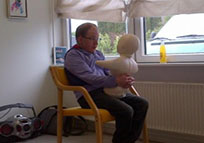Background
Telenoid is developed by the Japanese robotics researcher
Hiroshi Ishiguro. Telenoid is made of silicone and looks neither
like a man nor a woman, a child nor an adult. This allows the robot
to transfer presences of people of different ages and gender. Using
advanced video and audio technologies, a caregiver or a relative
can communicate with the citizen through the robot, but can also
remotely control the robot's arms, and thus, for example, give the
citizen a hug.
Objectives and Results
A number of partners in Patient@home, i.e. University of
Copenhagen, Advanced Telecommunications Research Institute
International (ATR), Osaka University, and Danish Institute of
Technology, have been testing
the robot, between October 2013 and April 2014, for usage in the
Danish health sector. The goal was to assess which target groups
Telenoid can be used by, and whether the robot is relevant to the
Danish welfare service. In addition there was a desire to explore
how human interaction with intelligent robots can create an
emotional relationship between robot and user.
Therefore, the project's contribution is knowledge on how
to integrate new technologies into the Danish sector for elderly
and disabled persons and the impact such technology will have in
practice for staff and employees. In addition, the project have
contributed with inputs on how to adapt Telenoid to the Danish
sector for the elderly and disabled, and with insight into the
interaction between humans and robots.
Telenoid has been tested at Benedict 's Home, a nursing
home in the Danish town of Fredensborg, and the Social Enterprise
Guldborgsund, an employment and activity programme for people with
reduced physical , mental or social functioning.
The testings showed, among other things, that
Telenoid have a set of potentials: for example it could create joy,
strengthen communiation skills, bring back memories, and be the one
you could confide to - and in that way work as the anonymous call
to a hotline, where you could find help to problem solving.
Additionally, it was found that operators should possess
extraordinary communicative and
relations-pedagogical capabilities beside
a sharp eye for the ethical aspects of the
human/robot-relation.
Furthermore, the test results will be a key element of a
doctoral dissertation at the University of Copenhagen. The purpose
here is to investigate how older people and people with impaired
physical, mental and social functioning living in dementia centres
and taking part in leisure activity programmes interpret, apply and
perceive the institutions' attempts to apply new relationship
technology in healthcare situations.